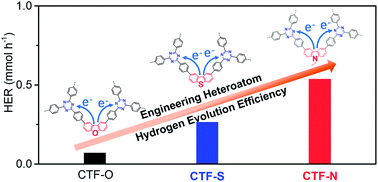Engineering heteroatoms with atomic precision in donor–acceptor covalent triazine frameworks to boost photocatalytic hydrogen production†
Abstract
Porous organic polymers (POPs) with conjugated structures, high surface areas and variable building blocks are shown to possess enormous potential to be used in photocatalytic hydrogen evolution reaction. However, photocatalytic performances of most POPs are impeded by insufficient charge transfer and rapid charge recombination. Herein, based on covalent triazine frameworks (CTFs), we show a strategy to boost the photocatalytic performance by enhancing charge transfer/separation, where the donors can be easily tailored through substituting different heteroatoms with atomic precision in a series of donor–acceptor CTFs, resulting in optimal energy levels and enhanced charge transfer ability. Among them, the N-doped fluorene (carbazole) bearing the strongest electron donating ability achieves the highest photocatalytic performance among POPs, with an exceptionally high hydrogen evolution rate of 538 μmol h−1 under visible light irradiation. Photophysical and electrochemical studies reveal that the high photocatalytic performance is attributed to high charge transfer efficiency and low charge recombination in these heteroatom-doped donor–acceptor CTFs. The work demonstrates that adjusting the push–pull interaction between the donor and acceptor via heteroatom engineering is an effective strategy to increase photocatalytic performance.



 Please wait while we load your content...
Please wait while we load your content...